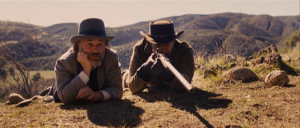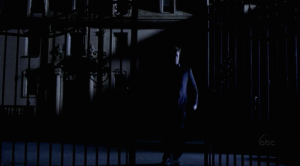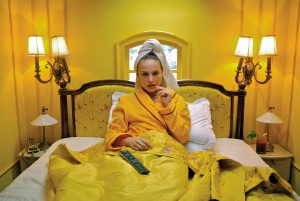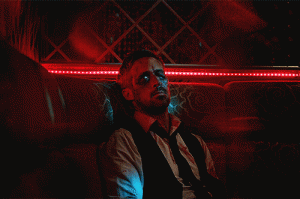Black and white films were once the only type of films made, and the thought of colour films was almost too good to be true and something of the future.
Although now days we only view films in colour, we see black and white films as a scary, mysterious, dark, very old school or even showing the past (in colour films), which is why I would like to explore how lighting was used in this particular medium to convey a different emotion.
Pretty much lighting in black and white films was the most important and influential source they could have and play around with. You could highlight a particular person, enhance the setting of the scene and overall change the mood of the entire film. Although we see black and white as a scary/mysterious view, it was here, lighting became crucial in making sure that effect didn’t happen.
 Lighting and contrast in film noir style can enhance the brutality of a violent scene. For example lighting is kept dark, conveying a sense of panic and confusion
Lighting and contrast in film noir style can enhance the brutality of a violent scene. For example lighting is kept dark, conveying a sense of panic and confusion

The lighting shown in this film is a hard back light, which highlights the edge of the character shown in the shot. What is also presented is a very soft fill light in the background which has a diffuser on it which is what has made the soft edge as well as that glow effect surrounding her image. This is the one of many ways directors used lighting in black and white films to enhance it perception of a happy/positive film
 This lighting technique was used in most and almost all horror films in black and white. It’s an easy way to enhance the characters image and facial expression. It also creates a strong use of shadow which is what creates this mysterious and almost vicious representation of the person or thing.
This lighting technique was used in most and almost all horror films in black and white. It’s an easy way to enhance the characters image and facial expression. It also creates a strong use of shadow which is what creates this mysterious and almost vicious representation of the person or thing.
The light is positioned below the character and is usually a very hard light with no diffuser.
 This shot, (which I have mentioned in other blog posts, The Clockwork Orange) is known as a very hard black light. This particular lighting technique is positioned behind the character and presents only a black figure in the shot. This is due to no light source shown at all on the face of the characters. It can be seen as mysterious or unknown depending on the situation.
This shot, (which I have mentioned in other blog posts, The Clockwork Orange) is known as a very hard black light. This particular lighting technique is positioned behind the character and presents only a black figure in the shot. This is due to no light source shown at all on the face of the characters. It can be seen as mysterious or unknown depending on the situation.
The shot I have shown uses smoke to diffuse the light so it doesn’t come across scary, almost heroic.
 Personally I love this shot. The light creates intense shadows on the individual but the light source seems to be coming from outside the window of the mans office, leaving the blind lines on the face of his character. This is commonly used in crime films, to give more of an extreme mystery look.
Personally I love this shot. The light creates intense shadows on the individual but the light source seems to be coming from outside the window of the mans office, leaving the blind lines on the face of his character. This is commonly used in crime films, to give more of an extreme mystery look.
 This shot is from the film “It’s A Wonderful Life”. A heart felt and moving film, which surrounds christmas. (It’s a great family film highly recommend!!!!)
This shot is from the film “It’s A Wonderful Life”. A heart felt and moving film, which surrounds christmas. (It’s a great family film highly recommend!!!!)
The shot I chose, is a very openly lit shot. It uses the family house lights as well as an artificial light source etc Fill light. Every character is brightly represented, you can see the emotions on all their faces and it enhances the positive moment the family has as they all hug together.










 This shot is of Nash leaving the unknown mystery house in a hurry to not be seen. That one artificial light has created an extreme amount of shadows on the house behind Nash as he leaves as well as a hard light source on the right side of frame highlighting his left side of his body.
This shot is of Nash leaving the unknown mystery house in a hurry to not be seen. That one artificial light has created an extreme amount of shadows on the house behind Nash as he leaves as well as a hard light source on the right side of frame highlighting his left side of his body.





















 This shot, (which I have mentioned in other blog posts, The Clockwork Orange) is known as a very hard black light. This particular lighting technique is positioned behind the character and presents only a black figure in the shot. This is due to no light source shown at all on the face of the characters. It can be seen as mysterious or unknown depending on the situation.
This shot, (which I have mentioned in other blog posts, The Clockwork Orange) is known as a very hard black light. This particular lighting technique is positioned behind the character and presents only a black figure in the shot. This is due to no light source shown at all on the face of the characters. It can be seen as mysterious or unknown depending on the situation. Personally I love this shot. The light creates intense shadows on the individual but the light source seems to be coming from outside the window of the mans office, leaving the blind lines on the face of his character. This is commonly used in crime films, to give more of an extreme mystery look.
Personally I love this shot. The light creates intense shadows on the individual but the light source seems to be coming from outside the window of the mans office, leaving the blind lines on the face of his character. This is commonly used in crime films, to give more of an extreme mystery look. This shot is from the film “It’s A Wonderful Life”. A heart felt and moving film, which surrounds christmas. (It’s a great family film highly recommend!!!!)
This shot is from the film “It’s A Wonderful Life”. A heart felt and moving film, which surrounds christmas. (It’s a great family film highly recommend!!!!)
 hot is of M. Gustave in prison. The blue light positioned behind his character, the bluely grey features on the wall and on the prison uniform creates a sense of cold, bitter and distort representation.
hot is of M. Gustave in prison. The blue light positioned behind his character, the bluely grey features on the wall and on the prison uniform creates a sense of cold, bitter and distort representation.



